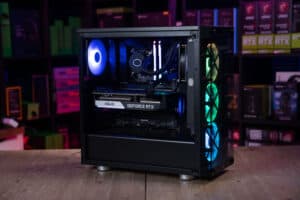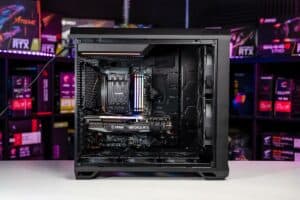What to do after building a PC?
What to do after building a PC? It can be confusing, but we're here to show you how.

WePC is reader-supported. When you buy through links on our site, we may earn an affiliate commission. Prices subject to change. Learn more
There’s nothing quite like building your first PC, but you aren’t all done after assembling your hardware. There are some important steps that you need to take to ensure that it runs smoothly and securely. Here’s what to do after building a PC.
Now Read: Best prebuilt gaming PC
Check that your PC POSTs
But before anything else, check that your PC is able to POST successfully
POST stands for Power On Self Test, and it is a process that checks if your PC’s hardware is functioning properly before loading the operating system.
If your PC does not POST, you may have loose connections or faulty components – and hopefully not the latter.
You can troubleshoot by checking the beep codes on your motherboard. You’ll need your motherboard’s user manual to understand what the “beeps” mean. It could be something very simple, like an incorrectly seated GPU or RAM.
Or it could be something more troublesome, like a fault within one of the numerous tiny components of the motherboard itself.
Adjust your BIOS settings
What to do after building a PC? You can access the BIOS by pressing a certain key (usually F2, F7, or F12) during startup. The key for your motherboard will be mentioned in its user manual.
Once the menu loads, you can explore and adjust a variety of settings. The setting we need to look at right now is the drive boot order. The drive that should be booted first is the one you’ll be installing your OS from.
You can also fine-tune your RAM clocks and timings, adjust your CPU clocks, and set up custom fan curves for your motherboard-controlled fans in the BIOS if you’re interested in doing so.
None of this is absolutely necessary, but if you have RAM with support for Intel XMP or AMD EXPO, it’s worth taking the extra few minutes to enable the technology for better memory performance.
Install your Operating System
The most common OS for PCs right now is Windows 10, but you can also go with Windows 11, Linux, or macOS if you have compatible hardware.
You will need a bootable media device, such as a USB flash drive or a DVD that contains the installation files. You can create one using another computer.
Here are instructions from Microsoft on Installing Windows from a USB flash drive.
Install the latest drivers
Drivers allow your PC’s hardware to communicate with the OS and other devices. Most of the drivers your system needs will already be installed in your OS and will update automatically when you connect to the internet.
You will have to install your GPU drivers manually, though. You can do so by visiting your GPU manufacturer’s website. Having the latest drivers helps you get more performance out of your hardware, so we recommend you don’t skip out on this step.
Get the latest chipset drivers as well, especially if you’re using one of the newer Ryzen 7000X3D or Intel 12th and 13th gen processors. These processors all have a somewhat complex architecture that relies heavily on driver optimization for effective operation.
Stress test your system (optional)
This step is optional, but it’s one that we recommend. Stress tests push your PC’s hardware to its limit. We recommend stress testing your CPU and GPU while using a temperature monitoring tool to note down the maximum temperature they reach.
If the temperature readings are high enough to cause thermal throttling or if your PC crashes during the stress test, you have an overheating problem. Ensure your CPU fan is properly seated with enough thermal paste to dissipate heat effectively.





